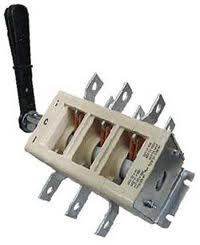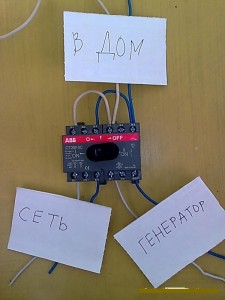Categories: Sharing experience, Autonomous power supply
Number of views: 119787
Comments on the article: 2
How to connect the generator to the network at home
 How to connect the generator to the house? It would seem that it could be easier, started the generator, connected to the house and everything, we live as before))). But not everything is as simple as it seems at first glance. In this article I would like to talk about how our people, wanting to save a little on materials, the work of qualified specialists, manage to connect gasoline and diesel generators.
How to connect the generator to the house? It would seem that it could be easier, started the generator, connected to the house and everything, we live as before))). But not everything is as simple as it seems at first glance. In this article I would like to talk about how our people, wanting to save a little on materials, the work of qualified specialists, manage to connect gasoline and diesel generators.
So, having recently been “visiting” with one of his comrades who, according to him, worked for many years as a ship electrician and knows everything about electricity, including Ohm’s law :) ...
So, the reason for the visit was that the gasoline generator refuses to give out vital 220 V.
At the first inspection of the "client", that is, the generator of the adjacent electrical household, the reason for the failure became clear - the automatic voltage regulator unit failed. Having talked a little with the owner of the gasoline generator and asking a couple of leading questions, I understood the reason for the failure of the mini-power station. Everything turned out to be quite simple.
During the main electricity outage, the customer connected the generator to the nearest outlet, while disconnecting the input circuit breaker, as a result, the whole house was supplied with electricity from the generator. When electricity appeared in the main network, the generator was turned off, the carrier was disconnected from the generator, and the input automaton turned on.
In fact, there are not so many ways to connect the generator to the existing house network, and the method described above is not suitable, since it is dangerous for both people and the generator. There is always the possibility that a person will make a mistake in the on-off sequence, which, incidentally, happened at this object. After the appearance of electricity, our “Ship Electric” drowned out the generator and forgot to remove the socket from it. The error result is already described above.
So, how to connect the generator? There are several ways to connect.
1) Flip switch
The easiest way is to use a changeover switch in three positions 1-0-2, that is, in the first position the object (home, office) will be connected to the industrial network, in position “0” the load is disconnected. When switching to position "2", the load is connected to a backup source of electricity - the generator.

To make it clearer how and what to connect here is the picture for you.

2) The simplest ABP block on contactors
The second method is a bit more complicated, but also has the right to life. In this case, we use the simplest ABP with the priority of the main input. The algorithm of the device is quite simple:
If urban electricity fails, go to the generator and start it; if there is no electricity in the main network, the generator contactor will close. When electricity appears in the main network, the generator contactor opens and the network contactor turns on.
Through simple manipulations, we can slightly improve this “semi-automatic power supply”, and then when electricity appears in the city network, an additional relay will jam the generator.
You can also install an additional time relay, and then, when the generator starts, the load will be turned on after a certain time, during which the generator will return to its normal mode of operation, that is, it (the generator) will warm up, the speed will stabilize.
This type of connection of a gasoline or diesel generator to an existing facility allows you to connect a generator with both manual start and generators equipped with an electric starter.

3) Automatic generator control unit
The third way to connect a gasoline, diesel or gas generator to the house.To switch the load from the city to the generator, we recommend using a full-fledged automatic transfer switch - automatic inclusion of backup power.
This method is perhaps the most optimal. In this case, the automation unit (ATS) monitors the presence of voltage in the main network and in the event of a power failure, the automation (ATS) independently starts a gasoline, diesel or gas generator, heats up and switches the load to the mini-power station. When electricity appears in the main network, the load is switched from the generator with the subsequent stopping of the gas or diesel generator.
The only negative, in this case, is the cost of the generator start-up device (ATS) and the cost of installation itself, since knowledge and skills in connecting the generator and automation are necessary for switching the generator and the ATS system. It is also necessary to consider that for the generator set to operate in automatic mode, the mini-power plant must be equipped with an electric starter.

Connection diagram for the ABP Contact EU controller
Since you have to regularly engage in the installation of generators and automation, in particular ATS “Portofranco”, I would like to give a couple of recommendations on choosing automation for controlling the generator.

If you have a simple gasoline or diesel generator installed as a backup (emergency) source of electricity and you don’t have special requirements for a generator, more precisely, for automation that should control this generator, feel free to take the Portofranco automatic transfer switch of the LE series (economy version). Despite its limited, in terms of settings, adjustments, functionality, automation copes with its task at 100%. Checked personally, and more than once))). And besides, save some money, which is also important ...
If your requirements for automation are more stringent and you need to add some additional devices to your home, office, enterprise power system, then, of course, it is better to pay attention to the CE or ME ABPs.
For example, recently it was necessary to carry out the not quite standard task of providing backup electricity to one house with a total area of 600 m². So, thanks to the flexibility of the ABP data, the task was completed with a bang))).

Another distinctive feature of the Portofranco ATS of the CE and ME versions is the presence of an RS-485 port, through which, using special software and an adapter adapter, it is possible to remotely monitor and control the operation of the ATS and the generator using a PC. The adapter and the necessary software can be purchased from the manufacturer of the ABP.
How to connect a single-phase generator to a three-phase network at home
There are several ways to connect. The very first is connecting the generator to a group of consumers allocated for these purposes.
Another way is to use a cross over switch, a switch to three positions 1-0-2, that is, in position "1" the load is powered from the industrial (city) network, the average position of the switch is "0" - the load is off, in position "2" - the load (house) is connected to a backup source of electricity, in this case it is a gasoline, diesel or gas generator.

Without really going into the design of the devices, we only note that the cross over switch or the three-position switch is relatively simple and consists of fixed contacts to which wires (load-city-generator) are connected and movable contacts that switch the load from the city to the generator and vice versa .
In the case of switching a three-phase city-load (consumer) load, three phases are switched, that is, three urban phases A-B-C come to the switch, the same three phases go to the load. In the case of switching the load to the generator, we need to make sure that all three phases receive electricity.
To do this, it is necessary to slightly upgrade our switch-switch, namely, to make a jumper between the phases A-B-C from the side of the generator connection. Now, in the case of switching the load to the generator, all three phases will receive electricity.
The next way to connect the load to a single-phase generator is the use of contactors. In this case, two contactors are used, one for supplying the load from the city mains, the second contactor is needed to connect the load to a backup source of electricity - a gasoline, diesel or gas generator. This method is acceptable when using ABP.
When the load is supplied from the city, all three phases connected to the contactor go to the load. When connecting the generator, as in the case of the cross over switch, on the terminals of the contactor in the place where the wire from the generator is connected, we need to install a jumper between phases A-B-C.
What is better to use for switching? Cross over switch or contactors?
If you are not going to use the automatic generator control system, then you need to install a cross over switch, but always three-position 1-0-2.
In the case of using the automatic start block by the generator - ABP, you can not do without the use of contactors.
Attention!!! When using a single-phase generator, it should be noted that if there are three-phase devices, they must be disconnected from the power supply during operation from the generator, as this can lead to failure of these devices.
What should not be done !!!
Do not connect the generator using the socket-socket method ...
It is impossible to connect the generator to the power grid of the house using two machines - one input, which is from the city, the second from the generator. Surely someday you will make a mistake and turn on the wrong machine ... What will happen next we will not talk, but in any case nothing good ...
In any case, if you intend to use the generator as a backup source of electricity for your home, office, production, we recommend contacting specialists who will install the generator faster and better.
Sergey Seromashenko
See also at bgv.electricianexp.com
:
